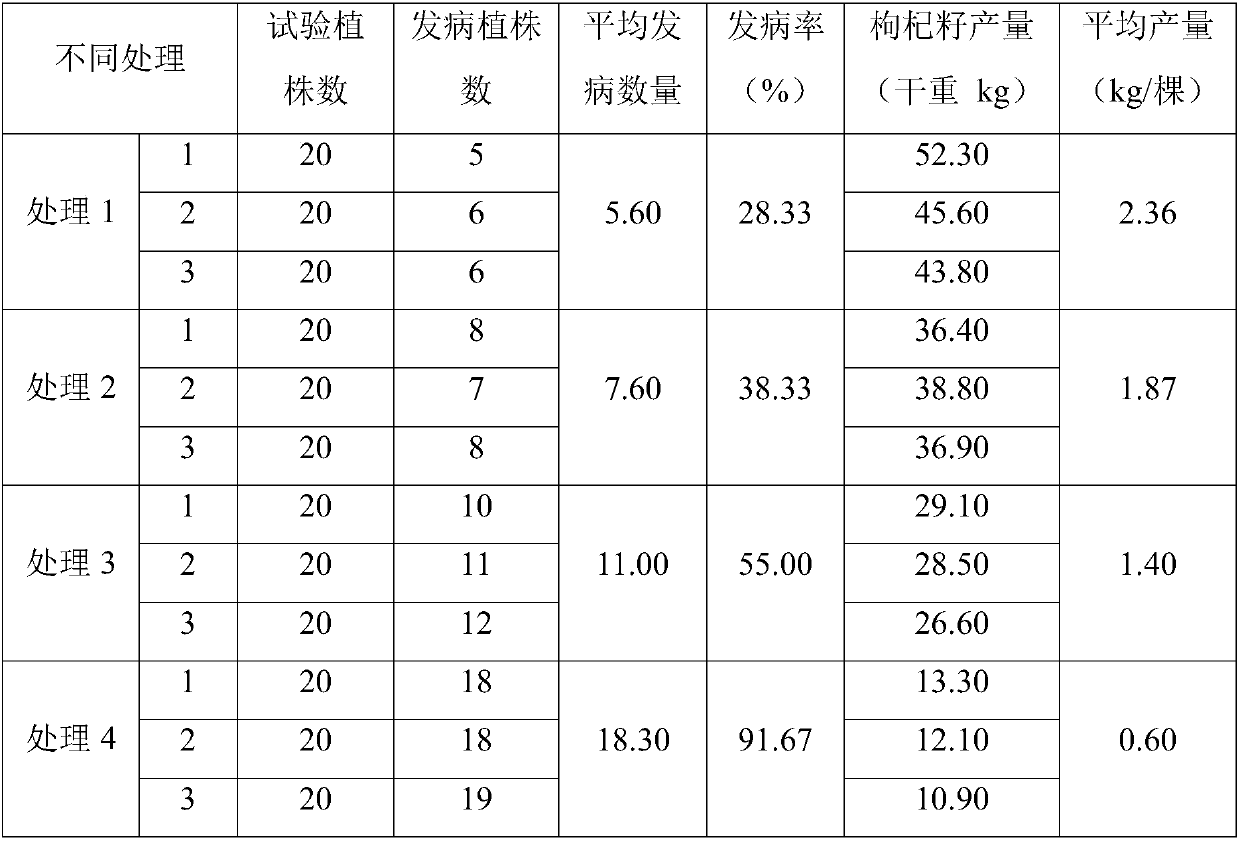Method for preventing and treating Chinese wolfberry root rot and preventing root rot-caused dead trees
A technology of wolfberry root and wolfberry, which is applied in the field of agricultural biology, can solve the problems of environmental pollution, time and effort, wolfberry planting and production loss, etc.
- Summary
- Abstract
- Description
- Claims
- Application Information
AI Technical Summary
Problems solved by technology
Method used
Image
Examples
Embodiment 1
[0053] A compound microbial bacterial agent for preventing and treating dead trees of wolfberry root rot, said composite microbial bacterial agent is mixed by volume ratio of 1:3 by the fermentation product of Bacillus amyloliquefaciens (Bacillus amyloliquefaciens) MES812 and the fermentation product of Bacillus subtilis (Bacillus subtilis) MES810 made;
[0054] The Bacillus subtilis (Bacillus subtilis) MES810 is preserved in the China Common Microorganisms Collection Management Center, and the preservation address is No. 3, No. 1, Beichen West Road, Chaoyang District, Beijing. The preservation date is August 10, 2017, and the preservation number is For CGMCCNo.14514;
[0055] The Bacillus amyloliquefaciens (Bacillus amyloliquefaciens) MES812 is preserved in the China Common Microorganisms Collection and Management Center, and the preservation address is No. 3, No. 1, Beichen West Road, Chaoyang District, Beijing, and the preservation date is August 10, 2017. The number is CG...
Embodiment 2
[0094] A compound microbial bacterial agent for preventing and treating diseased and dead trees of wolfberry root rot, said composite microbial bacterial agent is mixed by the fermentation product of Bacillus amyloliquefaciens (Bacillus amyloliquefaciens) MES812 and the fermentation product of Bacillus subtilis (Bacillus subtilis) MES810 in a volume ratio of 1:1 made;
[0095] The Bacillus subtilis (Bacillus subtilis) MES810 is preserved in the China Common Microorganisms Collection Management Center, and the preservation address is No. 3, No. 1, Beichen West Road, Chaoyang District, Beijing. The preservation date is August 10, 2017, and the preservation number is For CGMCCNo.14514;
[0096] The Bacillus amyloliquefaciens (Bacillus amyloliquefaciens) MES812 is preserved in the China Common Microorganisms Collection and Management Center, and the preservation address is No. 3, No. 1, Beichen West Road, Chaoyang District, Beijing, and the preservation date is August 10, 2017. T...
Embodiment 3
[0135] A compound microbial bacterial agent for preventing and treating dead trees of wolfberry root rot, said composite microbial bacterial agent is mixed by volume ratio of 1:2 by the fermentation product of Bacillus amyloliquefaciens (Bacillus amyloliquefaciens) MES812 and the fermentation product of Bacillus subtilis (Bacillus subtilis) MES810 made;
[0136] The Bacillus subtilis (Bacillus subtilis) MES810 is preserved in the China Common Microorganisms Collection Management Center, and the preservation address is No. 3, No. 1, Beichen West Road, Chaoyang District, Beijing. The preservation date is August 10, 2017, and the preservation number is For CGMCCNo.14514;
[0137] The Bacillus amyloliquefaciens (Bacillus amyloliquefaciens) MES812 is preserved in the China Common Microorganisms Collection and Management Center, and the preservation address is No. 3, No. 1, Beichen West Road, Chaoyang District, Beijing, and the preservation date is August 10, 2017. The number is CG...
PUM
 Login to View More
Login to View More Abstract
Description
Claims
Application Information
 Login to View More
Login to View More - R&D
- Intellectual Property
- Life Sciences
- Materials
- Tech Scout
- Unparalleled Data Quality
- Higher Quality Content
- 60% Fewer Hallucinations
Browse by: Latest US Patents, China's latest patents, Technical Efficacy Thesaurus, Application Domain, Technology Topic, Popular Technical Reports.
© 2025 PatSnap. All rights reserved.Legal|Privacy policy|Modern Slavery Act Transparency Statement|Sitemap|About US| Contact US: help@patsnap.com

